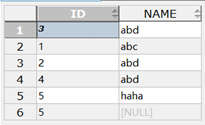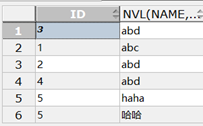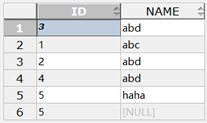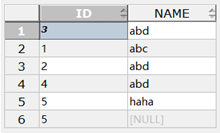Oracle常用函数
一、 单行函数
只处理单个行,且一个函数只返回一个结果
1、 concat(str1,str2)字符串拼接
select 'Hello '||'World' from dual;
等价于
select concat('Hello',' World') from dual;

注:
dual可以理解为oracle中存在的一张虚拟表,因为sql命令强制要求数据从某表中取得,也就是说sql语句中必须要有from命令,所以oracle定义了虚拟表dual,提供一些特殊字段的查询,例如时间日期、算术运算等功能。
2、 initcap(str)将每个单词首字母大写,其他小写
select initcap('hello world!') from dual;
--返回结果为'Hello World!'
select initcap('HELLO WORLD!') from dual;
--返回结果为'Hello World!'
3、 instr(x,find_string[,start][,occurrence])
返回指定字符串在某字符串中的位置,可以指定搜索的开始位置和返回第几次搜索出来的结果
start:开始位置
occurrence:返回第几次搜索出的结果
无结果返回0
select instr('Hello World!','o') from dual;
--从1位置开始搜索,返回第一次出现的o的位置,结果为5
select instr('Hello World!','o',6) from dual;
--从6位置开始搜索,返回第一次出现的o的位置,结果为8
select instr('Hello World!','o',1,2) from dual;
--从1位置开始搜索,返回第二次出现o的位置,结果为8
4、 length(str)返回表达式中的字符数
select length('hello world!') from dual;
--返回结果为12
select length('张三') from dual;
--返回结果为2
5、 lengthb(str)返回表达式中的字节数
字符集为UTF8,一个汉字三个字节
字符集为ZHS16GBK,一个汉字两个字节
select lengthb('张三') from dual;
--返回结果为6
select lengthb('hello world!') from dual;
--返回结果为12
6、 lower(str)将字符串转换为小写
select lower('HELLO WORLD!') from dual;
--返回结果为hello world!
7、 upper(str)将字符串转换为大写
select upper('hello world!') from dual;
--返回结果为HELLO WORLD!
8、 lpad(str,width[,pad_string])
当字符串长度不够时,左填充补齐,可以指定补齐时用什么字符补齐,若不指定,则以空格补齐
select lpad('hello',10,'*')
--返回结果为*****hello
9、 rpad(str,width[,pad_string])
当字符串长度不够时,右填充补齐,原理同左填充
原理同8、lpad()
10、 ltrim(x[,trim_string])
从字符串左侧去除指定的所有字符串,若没有指定去除的字符串,则默认去除左侧空白符
注:第二个参数的每一个字符都到第一个参数中去匹配
select ltrim('*++*-**hello','-+*')
--返回结果为hello
11、 rtrim(x[,trim_string])
从字符串右侧去除指定的所有字符串
原理同10、ltrim()
12、 trim(trim_string from x)
原理同10、11
select trim('*+' from '***+*Hello World!***+*') from dual;
--返回结果Hello World!
13、 nvl(x,value)
将一个NULL转换为另外一个值,如果x为NULL,则返回value,否则返回x值本身
select * from SCDLTEST.TEST1207

select id,nvl(name,'哈哈') from SCDLTEST.TEST1207

14、 nvl2(x,value1,value2)
如果x不为NULL,返回value1,否则,返回value2
select id,nvl2(name,'有姓名','无姓名') from SCDLTEST.TEST1207
15、 replace(x,search_string,replace_string)
从字符串x中搜索search_string字符串,并使用replace_string字符串替换。并不会修改数据库中原始值
select * from SCDLTEST.TEST1207

select replace(name,'a','b') from SCDLTEST.TEST1207

16、 substr(x,start[,length])
返回字符串中的指定的字符,这些字符从字符串的第start个位置开始,长度为length个字符;如果start是负数,则从x字符串的末尾开始算起;如果length省略,则将返回一直到字符串末尾的所有字符
select * from SCDLTEST.TEST1207

select id,substr(name,1,2) from SCDLTEST.TEST1207

二、 数值函数
1、 abs(value)
返回value的绝对值
select abs(-10)
--返回结果为10
2、 ceil(value)
返回大于等于value的最小整数
select ceil(2.3)
--返回结果为3
3、 floor(value)
返回小于等于value的最大整数
与2同理
4、 trunc(value,n)
对value进行截断,如果n>0,保留n位小数;n<0,则保留-n位整数位;n=0,则去掉小数部分
select trunc(555.666)
--返回值555,不加第二个参数默认去掉小数
select trunc(555.666,2)
--返回值555.66,保留小数点右侧2位
select trunc(555.666,-2)
--返回值500,截取小数点左侧2位
5、 round(value,n)
对value进行四舍五入,保存小数点右侧的n位。如果n省略的话,相当于n=0的情况
与trunc类似,不过会四舍五入
select round(555.666);
--返回结果为556,不加n时默认去掉小数部分
select round(555.666,2);
--返回结果为555.67
select round(555.666,-2);
--返回结果为600
三、 转换函数
1、 to_char(x[,format])
将x转化为字符串。 format为转换的格式,可以为数字格式或日期格式
select to_char('12345.67','99,999.99') from dual;
--返回结果为12,345.67
注:format gauss100不支持99,999.99格式
2、 to_number(x [, format])
将x转换为数字。可以指定format格式
select to_number('970.13') + 25.5;
--返回值为995.63
3、 cast(x as type)
将x转换为指定的兼容的数据库类型
select cast(12345.67 as varchar2(10)),cast('2015-7-07' as date), cast(12345.678 as number(10,2)) from dual;
返回结果:

4、 to_date(x [,format])
将x字符串转换为日期
select to_date('2012-3-15','YYYY-MM-DD')
--返回结果2012-03-15 00:00:00



